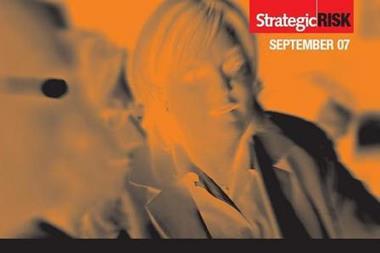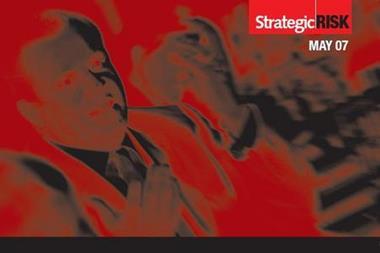SUE COPEMAN: Supply continuity is probably a concern which is at the forefront of all your minds. As you are essentially in the service sector, supply has got to be pretty key. So I wondered what sort of issues you have encountered when you have been looking at this? Geoff, what is your view here?
GEOFF MILLER: I presume we are talking about service continuity rather than our upstream supply chain?
SUE COPEMAN: I think I want to talk about both actually but maybe talk about service continuity first.
GEOFF MILLER: Well, we have a range of services that we provide. If I talk for example about electricity and water supply, I would guess most people within the service industry round the table are fairly heavily regulated and we have a number of key performance indicators that influence the regulators’ view and, in some areas, our price cap and subsequent price reviews. Service continuity is very important to us and performance against those key performance indicators is absolutely key for it. On the electricity distribution side of our business, for instance, customer interruptions and customer minutes lost are key performance measures and one of the components that drives our investment programme.
SUE COPEMAN: I think that is a very good opener. Is that something which the rest of you would agree with or have you got different considerations?
KITTY SINCLAIR: Well obviously we are in a different game. We are not a service driven company at all, we are a wholesale generator so we don’t deal with domestic market as such, we don’t have the same parameters that will hinder our continuity of supply from that viewpoint. So for us it’s about the supply chain, not service continuity.
KIM WATTS: I recognise everything that you said, Geoff, about the regulatory side of the business and having key performance indicators. We have a network asset management plan that is risk based, condition based monitoring that then drives our investment programme. In terms of our generation side, in terms of supply continuity, an issue for us at the moment and something that we have looked at quite closely are single point failures in power stations. Then there are the coal supplies to our power stations, gas supplies to our power stations, and the risks around those of which there are many.
In terms of generating, Kitty, do you have the same issues around single point failure in your generating plants on the basis that if relatively small pieces of equipment fail, that can take out your generating assets for a number of days?
KITTY SINCLAIR: That is a very broad question. We have hundreds of elements, which singularly contribute to the continuity of the unit itself. There obviously are elements in that which are more key than others and which may in turn cause the unit to trip, ie bring the unit off. We would identify what those units were, what those elements were and try to maintain a relative maintenance regime around it so it doesn’t actually occur. Then we would aim to have spares so to speak and a remedy to try and bring that back as soon as possible.
GEOFF MILLER: I recognise what you say about a risk based investment strategy. Certainly in our water business the regulator is very much pushing us in that direction. I think there is an active engagement with all the water companies to move along that road so that we have a far more refined and mature understanding of where our principal exposures are in our asset base rather than having a variety of approaches perhaps dependent on historical origins or an individual manager’s or a legacy strategy approach to it.
KITTY SINCLAIR: It is interesting to hear you say that because obviously for all of us investment is a key issue and where do we invest? As regards our regulator, their key interest is safety and our investment must ensure that the integrity of the safety cases around the plants are maintained and also that we look at worker security, etc. But I am sure that we all feel that there is the other side of the coin which is the commercial aspects of investment, where do you put your money in order to get your next mega watts? So there is the balancing act between investing for the continuity and security of the unit and then investing to make sure you can generate more income.
SIMON ALLEN: You made a good point in saying that health and safety is one of the drivers. I’d like to ask everybody what they think the key drivers are. What is driving your risk based decisions. Is it reputation, loss of revenue or the penalties that you might face?
KITTY SINCLAIR: We are a heavily regulated entity, nuclear generation is governed by a separate independent government body, and we must ensure that safety is our number one priority, particularly nuclear safety. And if we deviated or seemed to deviate from that, the safety case for that particular unit would not be supported and we can be shut down by an independent body. So for us it is essentially making sure that we apply a very prudent approach to safety and we always take the action that is necessary as soon as possible. We would never delay in the means of safety and we are always more cautious than we need to be at times.
GEOFF MILLER: I don’t think there is a simple answer to that question. In simple terms, I could say that health and safety is always at the top of our agenda. In a sense that is true, but there are probably half a dozen organisational drivers which reflect the complexity of our own corporate objectives and also the stakeholder mix that we have. We can’t ignore customer service criteria or environmental criteria or commercial criteria that our shareholders have a keen interest in. But I think each of us would recognise that an organisation that doesn’t pay appropriate attention to health and safety suffers on all those fronts. It is unlikely that you would be successful if you didn’t have a rigorous health and safety policy and commit firmly to it.
SUE COPEMAN: Does that involve things like training staff?
GEOFF MILLER: One of the things I have seen is an increased maturity in the organisation’s commitment to training generally. Health and safety has always been a kind of gold standard in terms of training but more broadly we have looked and are looking to develop our workforce with more formal accreditation than has previously been the case. A generation ago, somebody might have come onto a plant and served a period of ‘apprenticeship’ with the current operator and then been given responsibility for that plant, and the strengths and weaknesses of the incumbent would have been transferred to the new joiner. Now we look for more comprehensive training and accreditation and regular re-certification of our operators than was previously the case. Health and safety is a strong component within that.
SIMON ALLEN: Do you think that the environment surrounding health and safety has changed significantly over the past few years? I don’t just mean in terms of far more rigorous legislation in place and higher penalties, but do you think there has been a big shift with fear of law suits and things that have come about in the last few years.
KITTY SINCLAIR: I don’t know necessarily that the change in attitudes has been from a fear of law suits. I think that there is just a recognition amongst all businesses that if you tackle things from the ground up then you are going to have a much more safe and productive workplace than if you take a piecemeal approach to it, concentrating on very high level issues and not dealing with the day to day working practices of your staff. We have a system that everyone has a task rated risk assessment which must be carried out for every job they do and someone will check that. We started at that very basic level and that supports everything that is done because everyone stops and thinks before they do something. It’s an attitude, a cultural thing, rather than being driven by any external force.
GEOFF MILLER: I think we have seen a modest increase in litigiousness but to some extent that is probably more around our customers rather than our other stakeholders. However, we are a heavily construction orientated organisation and what has perhaps changed over the last ten years has been the construction design and management regulations that came in in the early to mid 1990s. I think we are having many of the same challenges that the rest of the construction industry is, facing the same questions as to what benefit have these actually brought to health and safety as opposed to imposing another level of documentation and process.
One of the changes that we have been introducing recently has been to review the health and safety policies and procedures that exist in our utilities solutions business as part of a broader initiative across the company to engender a greater sense of ownership and accountability for those individual policies. Previously it was a corporate policy, there wasn’t necessarily a clear owner. Now there is a clear owner for each of those policies. I think that is part of an agenda that seeks to move our culture from being risk averse to being risk aware. It is very much the point you were making, Kitty, about stopping, identifying, considering the implications of a decision and an outcome and then taking a risk based judgement.
SUE COPEMAN: It’s interesting that we started talking about supply continuity but the focus has very much switched to health and safety. The way the discussion has gone suggests that actually health and safety is the key issue.
GEOFF MILLER: Well, coming back to the broader theme of supply continuity, that is absolutely vital for us. We talked about down stream and up stream relationships. Kitty is from the generation side, we don’t have a direct relationship with them, we provide their product through our distribution network, it having been passed to us by a third party, the National Grid, so our relationship is less with the ultimate upstream provider but more with the intermediary, the National Grid.
SUE COPEMAN: So in a sense Kitty is your end supplier as it were but with somebody else in-between?
GEOFF MILLER: Yes but given the diversified nature of the generation industry if there were problems in Kitty’s particular organisation that would probably not impact us. It would be major issue for her but less for us. To some extent that reflects the resilience of the UK’s transmission infrastructure.
SUE COPEMAN: You are also involved in water supply, aren’t you, and I saw recently that the Environment Agency was talking about a long term plan involving managing water supply in the environment of climate change. I think everybody in this country used to think that water was the one thing that was there and fairly cheap and easy to get and it clearly isn’t now. Does your work in any way involve managing or advising in that sort of area?
GEOFF MILLER: Well certainly a significant change for us has been the appointment of an environmental director within our utilities solutions business. There is an increased focus on our carbon footprint so that is one element of change.
You mention the Environment Agency’s stance and I also noticed recently that Thames Water got approval for a desalination plant for the South East – and that’s a very unusual step for a water company within the UK. What we are recognising is that climate change is a significant issue for us. The regulatory process generally works on a five year cycle and to address the kind of issues that we are facing or can see we are facing with climate change, we are probably going to have to move to a far longer planning horizon. We are encouraging the regulator to think towards a 25 year horizon for investment planning and strategy.















